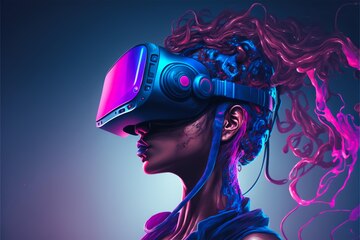Comparison and Contrast of the Advancements in AI and VR
Artificial Intelligence (AI) and Virtual Reality (VR) have both experienced significant advancements over the past few years, each transforming various industries in distinct ways. While both technologies leverage cutting-edge innovations, their areas of focus and applications vary widely.

1. Advancements in Artificial Intelligence
1.1. Machine Learning and Deep Learning
AI advancements have predominantly been driven by machine learning, particularly deep learning, which has been the core of progress in areas like vision, speech recognition, and natural language processing (NLP). Generative Adversarial Networks (GANs), a notable breakthrough, have enabled the production of highly realistic artificial content, such as images and videos.
1.2. NLP and Language Models
In recent years, AI has made significant advancements in language processing through the development of models like GPT-3 and BERT, which have revolutionized machine translation, text generation, and conversational interfaces. These models can generate human-like text and are used in applications such as chatbots and writing aids.
1.3. Applications in Healthcare
AI is increasingly used in healthcare for clinical decision support, drug discovery, and medical imaging. AI tools enhance diagnostics and personalized treatments, helping clinicians to make informed decisions. Furthermore, AI-driven predictive analytics and risk stratification have advanced capabilities in patient care and management.
1.4. Robotics and Autonomous Systems
Robotics, bolstered by AI, has seen substantial development, particularly in industrial applications and autonomous vehicles. AI-powered robots are now capable of performing complex tasks with agility and precision, although many systems remain confined to controlled environments. Autonomous vehicle technologies have advanced but still face significant challenges.
2. Advancements in Virtual Reality
2.1. Improved Hardware and User Experience
VR technology has advanced significantly in terms of hardware, with headsets becoming lighter, more comfortable, and more affordable. Companies like Apple, Meta, and Sony are continuously innovating to enhance the user experience with high-resolution displays and improved ergonomic designs.
2.2. Expanding Applications in Various Industries
While traditionally associated with gaming, VR has expanded its applications across multiple sectors, including education, healthcare, and architecture. In healthcare, VR is used for medical training, surgery simulation, and patient therapy, offering immersive experiences that are highly beneficial for learning and treatment.
2.3. Growth in Content Creation
The creation of immersive content has also been a focus, with VR cinema emerging as a new storytelling medium. This evolution offers new ways for audiences to experience narratives, providing communal and interactive experiences that go beyond traditional media.
2.4. Impact of the Pandemic
The COVID-19 pandemic accelerated the adoption of VR, particularly in remote working and online education, as VR provided a means to simulate real-world environments virtually and maintain engagement.
3. Comparison and Contrast
3.1. Technological Focus
While AI focuses more on data-driven decision-making, analytics, and automation, VR is centric to creating immersive, interactive experiences. AI expands capabilities in various systems through learning algorithms, whereas VR mainly focuses on simulating environments for user interaction.
3.2. Industry Impact
Both AI and VR are transforming healthcare, but in distinct ways: AI focuses on diagnostics and personalized medicine, while VR emphasizes training and therapeutic experiences. In education, AI tools personalize learning experiences, whereas VR provides hands-on, experiential learning opportunities.
3.3. Adoption Challenges
AI faces challenges related to data privacy, ethical use, and integration into existing systems. In contrast, VR's challenges lie in the development of high-quality content and affordable hardware improvements.
In conclusion, while both AI and VR are pioneering technologies shaping the digital landscape, they diverge in application, with AI excelling in data processing and predictive capabilities, and VR enhancing experiential interactions and simulations.
Comments
Post a Comment